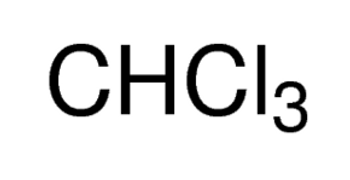Description
Chloroform, biotech. grade, ≥99.8%, contains 0.5-1.0% ethanol as stabilizer, 1L
Synonym(s):
Methylidyne trichloride, Trichloromethane
Empirical Formula (Hill Notation):
CHCl3
CAS Number:
67-66-3
Molecular Weight:
119.38
Beilstein:
1731042
MDL number:
MFCD00000826
PubChem Substance ID:
329757487
NACRES:
NA.04
grade
biotech. grade
Quality Level
100
vapor density
4.1 (vs air)
vapor pressure
160 mmHg ( 20 °C)
assay
≥99.8%
form
liquid
contains
0.5-1.0% ethanol as stabilizer
impurities
<0.01% water
evapn. residue
<0.0003%
color
APHA: ≤10
refractive index
n20/D 1.445 (lit.)
pH
5.2-6.4
bp
60.5-61.5 °C (lit.)
mp
−63 °C (lit.)
density
1.48 g/mL at 25 °C
1.492 g/mL at 25 °C (lit.)
cation traces
Pb: ≤0.05 ppm
SMILES string
ClC(Cl)Cl
InChI
1S/CHCl3/c2-1(3)4/h1H
InChI key
HEDRZPFGACZZDS-UHFFFAOYSA-N
Chloroform is a colorless, volatile chlorinated organic solvent whose vapors have a narcotic effect. It is susceptible to degradation with time, which can be suppressed by adding ethanol as a stabilizer. Since ethanol is added in higher concentration it leads to increase in polarity which may have a potential influence on some of the applications. Low water content, minimal residue and clean UV spectra are the special characteristics of this biotech grade solvent. It can be utilized for biotechnological processes like protein sequencing, peptide and oligonucleotide synthesis. Reports suggest that chloroform stabilized with ethanol reduces chances on creating artifacts during the chromatographic separation after extraction of anthracyclines from biological matrices.
Application
Chloroform may be used in the following processes:
- Synthesis of colloidal hydrophobic CdSe core nanocrystals (quantum dots).
- Preparing phospholipid solutions.
- As a solvent in the photolysis reaction of ruthenium complexes.
- Solvent for recrystallization.
- Reference compound to detect the presence of chloroform in Tobacco smokes.
- Extractant in solvent extraction process.
Packaging
1, 2 L in Sure/Seal™
Signal Word
Danger
Hazard Statements
H302 - H315 - H319 - H331 - H336 - H351 - H361d - H372
Precautionary Statements
P201 - P301 + P312 - P302 + P352 - P304 + P340 + P311 - P305 + P351 + P338 - P308 + P313
Hazard Classifications
Acute Tox. 3 Inhalation - Acute Tox. 4 Oral - Carc. 2 - Eye Irrit. 2 - Repr. 2 - Skin Irrit. 2 - STOT RE 1 Oral - STOT SE 3
Target Organs
Central nervous system
Storage Class Code
6.1D - Non-combustible, acute toxic Cat.3 / toxic hazardous materials or hazardous materials causing chronic effects
WGK
WGK 3
Flash Point(F)
does not flash
Flash Point(C)
does not flash





